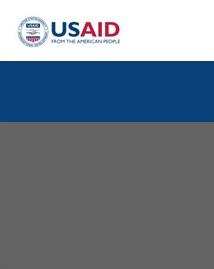This is an overview of the USAID/Indonesia FY 2021 Tuberculosis (TB) Roadmap, implemented with FY 2020 budget. It was developed in consultation with the National TB Program (NTP) and with the participation of national and international partners involved in TB prevention and care in the country.
While Indonesia has made progress over the past decade toward reducing TB incidence and increasing treatment success rates, significant challenges to eliminating TB remain. Among the top 30 high TB burden countries, Indonesia ranked third; and among the high multidrug-resistant TB (MDR-TB), Indonesia ranked fifth.1 In 2018, Indonesia had an estimated incidence of 845,000 and estimated mortality of 93,000 TB cases.2 TB is the fourth highest cause of death in Indonesia overall, and among Indonesians aged 15 to 49 years, it is the number one cause of death by a communicable disease.3 In 2018, only 568,865 (67 percent) of the 845,000 estimated TB cases were notified.4 Thus, more than one-third of TB patients remain either undiagnosed or diagnosed but not notified to the NTP. Of the new cases diagnosed and started on care, 85 percent were successfully treated.5 Additionally, in 2018, an estimated 24,000 patients developed drug-resistant TB (DR-TB)/MDR-TB; however, only 9,038 cases were diagnosed and only 46 percent of those cases were initiated on treatment.6
The current National Strategy of TB Care and Prevention in Indonesia 2020-2024 aims to accelerate the TB elimination efforts in Indonesia by 2030 and to end TB in Indonesia by 2050.7 To achieve these goals the National Strategy will strengthen leadership of district- and city-based programs; increase access to high quality, patient-centered TB diagnostic and treatment service; control TB infection and optimize the provision of TB preventive therapy (TPT); increase utilization of research results on screening technologies, diagnostics, and treatment regimens; increase the participation of communities, partners, and other multisectoral actors in TB control efforts; and strengthen program management by strengthening the overall health system.
TABLES
The following tables illustrate the distribution by technical area of the Global Fund* and USAID TB budget for Indonesia that will be used for the implementation of Indonesia’s FY21 TB Roadmap (Table 1) and the core indicators that will be used to monitor implementation of Indonesia’s TB Roadmap and the country's progress towards the United Nations General Assembly High-Level Meeting on TB targets (UNGA targets) (Table 2).
Table 1: USAID Budget for Indonesia per Technical Area*
| Technical Area | USAID TB budget for FY21 | USAID Percentage of TB budget for FY21 |
| REACH | $5,372,719 | 36% |
| CURE | $2,509,752 | 17% |
| PREVENT | $2,530,909 | 17% |
| SELF-RELIANCE | $4,586,620 | 31% |
| TOTAL BUDGET: | $15,000,000 | 100% |
*USAID is working with the Global Fund to provide similar budget data for next year. It is anticipated this information will be added once the discussions have been finalized.
Table 2: TB Core Indicators in Indonesia from 2015-2019 and Targets from 2020-2022
| # | Name | 2015 | 2016 | 2017 | 2018 | 2019 | 2020* | 2021* | 2022* |
| REACH: Increased DS- and DR-TB case notification | |||||||||
| 1 | TB Detection | 39.4% | 43.3% | 52.4% | 66.7% | 67% | UNGA target: 808,400 | UNGA target: 758,200 | UNGA target: 707,900 |
| 2 | Bacteriological Diagnosis Coverage (Pulmonary TB) | 64.2% | 58.9% | 54.0% | 49.7% | 52% | — | — | — |
| 3 | Childhood TB Notifications | 28,412 | 32,602 | 52,944 | 60,892 | 70,092 | UNGA target: 68,000 | UNGA target: 69,000 | UNGA target: 70,000 |
| 4 | Drug-Resistant TB Notifications | 2,173 | 2,757 | 5,121 | 9,118 | 11,496 | UNGA target: 14,200 | UNGA target: 20,500 | UNGA target: 21,900 |
| 5 | Private Sector TB Notifications | 31,002 | 37,541 | 58,633 | 101,839 | 109,216 | — | — | — |
| 6 | Contact Investigation Coverage** | — | — | — | — | 3% | — | — | — |
| CURE: High treatment success rate in DS- and DR-TB | |||||||||
| 7 | TB Treatment Success Rate | 85.1% | 85.8% | 84.7% | 83.0% | — | — | — | — |
| 8 | Drug-Resistant TB treatment Success Rate | 46.9% | 47.1% | 45% | — | — | — | — | — |
| PREVENT: Prevent TB transmission and development | |||||||||
| 9 | TPT Coverage | 591 | 877 | 13,761 | 21,841 | 27,959 | UNGA target: 305,490 | UNGA target: 478,650 | UNGA target: 587,600 |
| SELF-RELIANCE: Commitment and sustainability | |||||||||
| 10 | Proportion of Domestic Financing for TB | — | — | — | 68.0% | 38% | — | — | — |
*Projected UNGA targets.
**Based on available data.

